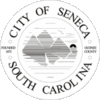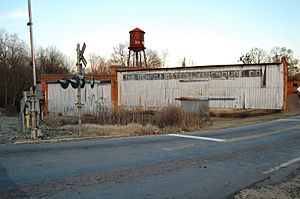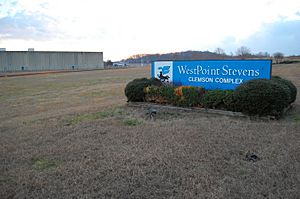Seneca, South Carolina facts for kids
Quick facts for kids
Seneca, South Carolina
|
|||
|---|---|---|---|
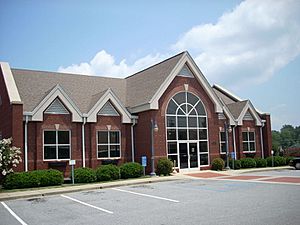
Seneca City Hall
|
|||
|
|||
| Motto(s):
"City of Smiles, City with Style"
|
|||
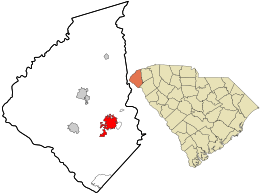
Location in Oconee County and the state of South Carolina.
|
|||
| Country | United States | ||
| State | South Carolina | ||
| County | Oconee | ||
| Area | |||
| • Total | 8.30 sq mi (21.49 km2) | ||
| • Land | 8.24 sq mi (21.35 km2) | ||
| • Water | 0.05 sq mi (0.14 km2) | ||
| Elevation | 951 ft (290 m) | ||
| Population
(2020)
|
|||
| • Total | 8,850 | ||
| • Density | 1,073.64/sq mi (414.55/km2) | ||
| Time zone | UTC−5 (Eastern (EST)) | ||
| • Summer (DST) | UTC−4 (EDT) | ||
| ZIP codes |
29672, 29678, 29679
|
||
| Area codes | 864, 821 | ||
| FIPS code | 45-65095 | ||
| GNIS feature ID | 1250833 | ||
Seneca is a city in Oconee County, South Carolina, United States. The population was 8,102 at the 2010 census. It is the principal city of the Seneca Micropolitan Statistical Area (population 74,273 at the 2010 census), an (MSA) that includes all of Oconee County, and that is included within the greater Greenville-Spartanburg-Anderson, South Carolina Combined Statistical Area (population 1,266,995 at the 2010 census). Seneca was named for the nearby Cherokee town of Isunigu, which English colonists knew as "Seneca Town".
Contents
History
In the antebellum period, this area was part of the Pickens District, South Carolina. The state had used jurisdictions such as parish, county, district, and county again in its history. Oconee County was not organized until 1868, after the American Civil War.
Seneca was founded in 1873, during the Reconstruction era, as the railroad town "Seneca City", named for the Seneca River and a historic Cherokee town known as Isunigu. It was called Seneca in a kind of transliteration by British colonists.
Seneca City was developed at the intersection of the Blue Ridge Railroad and the newly built Atlanta and Charlotte Air Line Railroad. Both lines are now part of the Norfolk Southern Railway. A. W. Thompson and J. J. Norton, who were locating engineers for the Air Line Railroad, purchased the land from Col. Brown of Anderson, South Carolina, also in the large Pickens District. A stake marking the center of town was driven into the ground at the intersection of the railroad tracks and the current Townville Street. The land was divided into lots for a one-half mile from the stake. An auction was held on August 14, 1873. The town was given a charter by the state legislature on March 14, 1874. In 1908, the name was changed to the shorter Seneca.
Seneca developed as a marketing and shipping point for cotton, the major commodity crop in this uplands area. During the harvest, wagons bringing cotton would line up for blocks from the railroad station. A passenger terminal, several hotels, and a park were built near the railroad tracks. Recently, this park was named the Norton-Thompson Park in honor of the city's founders.
The first school was built in 1874. The community also was home of the Seneca Institute - Seneca Junior College, established here in 1899 as an historically black college. It was reserved for African-American students until 1939.
Textile mills were built in the area; a plant-and-mill village was built in 1893 by the Courtenay Manufacturing Company in Newry on the Little River, which supplied hydropower for the mill. W.L. Jordon built another textile plant and mill village east of Seneca. This village has been called Jordania, Londsdale, and Utica; these changes accompanied changes in ownership of the plant. The J. P. Stevens Plant, which was later called the Westpoint Stevens Plant, was a large textile mill built on Lake Hartwell. Its workforce was integrated, unlike most other plants that hired only whites. Many other textile mills were developed in this area. These plants were the main industry for Seneca for the first half of the twentieth century. With the shift of these jobs overseas, these textile mills are now closed.
In the late 20th century, major dam projects were constructed n the Keowee and other local rivers, to support recreation and public utilities. These projects created three major lakes: Lake Hartwell in 1963, Lake Keowee in 1971, and Lake Jocassee in 1974, stimulating development in Seneca and the region. Duke Power's Oconee Nuclear Station was built on Lake Keowee, drawing cooling water for its operations from the lake.
The recreation provided by the lakes, and other attractions, such as nearby Clemson University attracted many retirees from other parts of the country. Retirement communities have been built in the area. Concerned about over-development, some residents formed the Friends of Lake Keowee Society (FOLKS) to advocate for balance.
Early on April 13, 2020, a high-end EF3 tornado struck residential areas south and east of Seneca. Many buildings were damaged or destroyed and one person was killed.
National Register of Historic Places listings
In and around Seneca, there are a number of historic buildings and districts that are on the National Register of Historic Places:
- Seneca Historic District was listed in 1974. It is located south of the railroad tracks. The district consists of several homes and three churches that were built in the late nineteenth and early twentieth centuries. The houses have architectural styles that were popular in the period. It also includes a log cabin from the mid-nineteenth century that was moved from Long Creek, South Carolina. The South Carolina Department of Archives and History has additional pictures and information, copies of the nomination forms, and a map of the district.
- Ram Cat Alley Historic District was listed in 2000. It is a twenty-one-building commercial district built in the 1880s to the 1930s. The name of the street came from cats that gathered around a meat market. Many of these buildings have been rejuvenated and now house restaurants, shops, and professional offices. The South Carolina Department of Archives and History has additional pictures and information, a copy of the nomination form, and a map.
- Newry Historic District was listed in 1982. It is a historic textile mill village near Seneca. The South Carolina Department of Archives and History has additional pictures and information, a copy of the nomination form, and a map.
- Alexander-Hill House
- Faith Cabin Library at Seneca Junior College
- McPhail Angus Farm
- Old Pickens Presbyterian Church
Geography
Seneca is located at 34°41′3″N 82°57′21″W / 34.68417°N 82.95583°W (34.684145, -82.955778).
According to the United States Census Bureau, the city has a total area of 7.1 square miles (18 km2), of which 7.1 square miles (18 km2) is land and 0.04 square miles (0.10 km2) (0.56%) is water.
Demographics
| Historical population | |||
|---|---|---|---|
| Census | Pop. | %± | |
| 1880 | 382 | — | |
| 1900 | 920 | — | |
| 1910 | 1,313 | 42.7% | |
| 1920 | 1,460 | 11.2% | |
| 1930 | 1,929 | 32.1% | |
| 1940 | 2,155 | 11.7% | |
| 1950 | 3,649 | 69.3% | |
| 1960 | 5,227 | 43.2% | |
| 1970 | 6,027 | 15.3% | |
| 1980 | 7,436 | 23.4% | |
| 1990 | 7,726 | 3.9% | |
| 2000 | 7,652 | −1.0% | |
| 2010 | 8,102 | 5.9% | |
| 2020 | 8,850 | 9.2% | |
| U.S. Decennial Census 2020 |
|||
2020 census
| Race | Num. | Perc. |
|---|---|---|
| White (non-Hispanic) | 5,556 | 62.78% |
| Black or African American (non-Hispanic) | 2,143 | 24.21% |
| Native American | 25 | 0.28% |
| Asian | 108 | 1.22% |
| Pacific Islander | 3 | 0.03% |
| Other/Mixed | 484 | 5.47% |
| Hispanic or Latino | 531 | 6.0% |
As of the 2020 United States census, there were 8,850 people, 4,043 households, and 2,138 families residing in the city.
Education
Seneca has a lending library, a branch of the Oconee County Public Library.
Until June 2020, it was the headquarters of the National Council of Examiners for Engineering and Surveying (NCEES), the council that deals with the examination for engineers and surveyors. On that date, the NCEES moved to Greenville, South Carolina.
Notable people
- Jimmy Orr, retired All-Pro National Football League player and Super Bowl champion.
- Willie Aikens, Major League Baseball player
- Bennie Cunningham, National Football League player
- John Edwards, former U.S. Senator from North Carolina (1999–2005), and 2004 Democratic nominee for Vice President under John Kerry; candidate for president in 2008
- Lindsey Graham, U.S. Senator from South Carolina since 2003
- Clarence Kay, National Football League player
- Marshall Parker, politician
- Marv Rackley, Major League Baseball player
- Needtobreathe, Christian rock band
See also
 In Spanish: Seneca (Carolina del Sur) para niños
In Spanish: Seneca (Carolina del Sur) para niños



